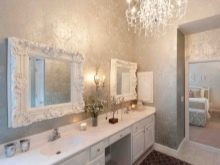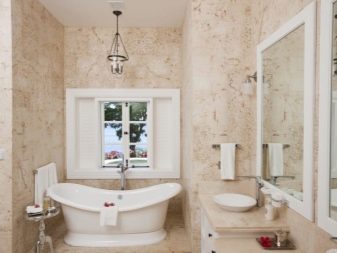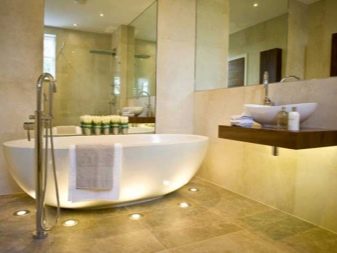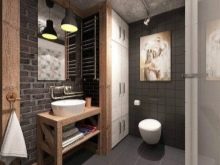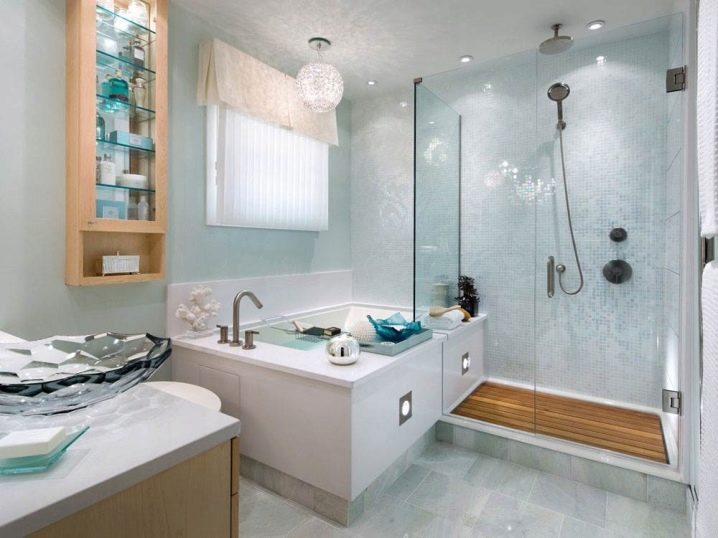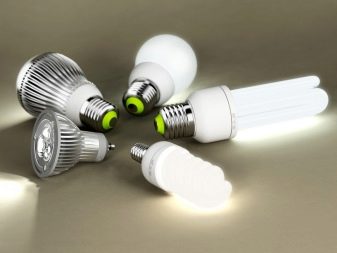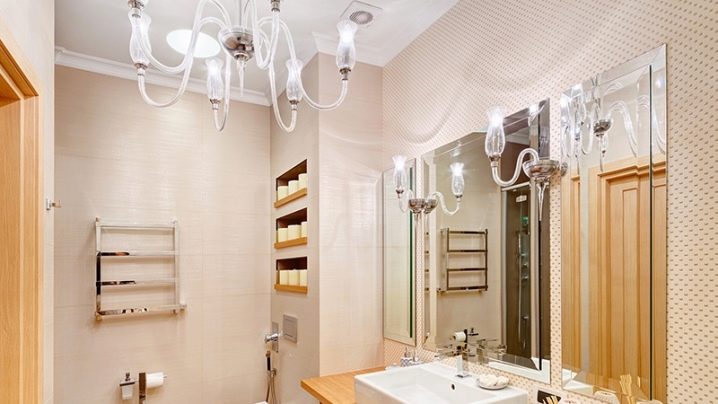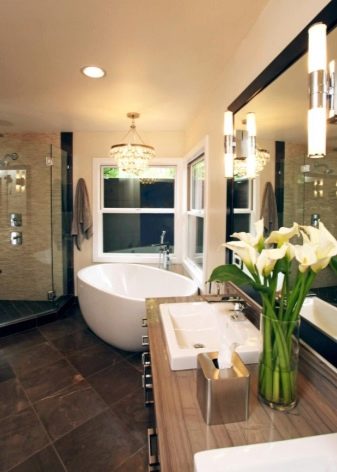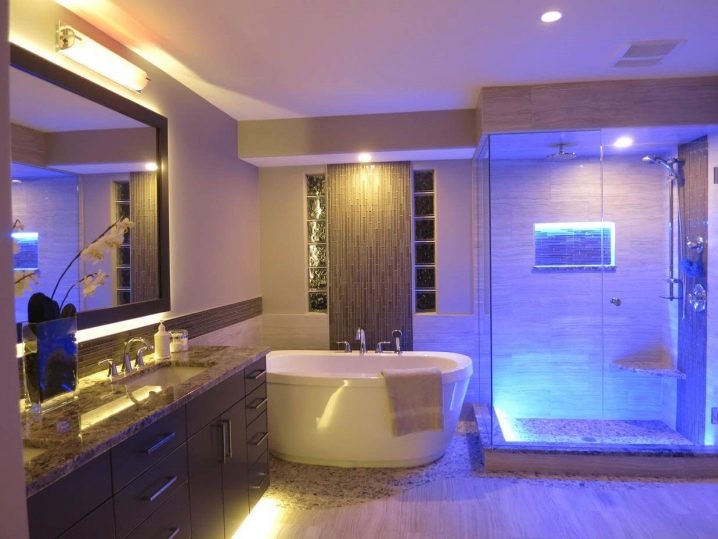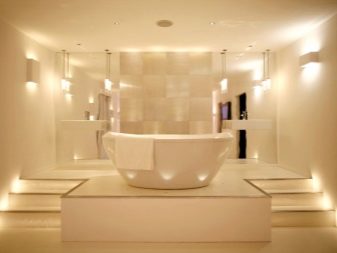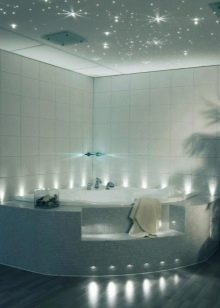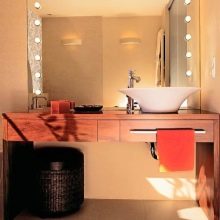Bathroom fixtures
In the arrangement of the bathroom and the living room as a whole, few people pay due attention to lighting fixtures and lighting concepts. But it has a strong influence on the interior space and its functionality. Lighting can elevate the interior, bring a zest to it, work with the visual perception of the dimensions of the furniture or the floor space.
Lighting features
The time when the bathroom was used only for its intended purpose, is gone. Today, it is filled with a large number of additional elements required by its owner: a shower, bath, sink, washing machine, clothes dryer, all sorts of areas for storing personal belongings and household chemicals, mirrors and much more.
However, besides the main purpose,the owner has a need for comfort and organization of a zone for relaxation, which will allow him to relax as much as possible after a hard day’s work.
When developing a bathroom lighting plan it is important to consider a large number of factors: you need to make the interior stylish, functional and safe.
The main feature of this room is the lack of daylight, since to a greater extent the layout of this zone does not provide for window openings, or the owner prefers to curtain them. However, regardless of the presence or absence of a window, the lighting, according to the recommendations of specialists, should be as bright and non-irritating to the eyes as close to daylight.
In addition to the light spectrum, it is important to take into account the fact of technical and operational safety of electrical appliances, as well as the correct location of luminaires. In order for the light concept to comply with safety standards, it will be quite enough to install the lamps in several zones, as well as to choose the right device and the appropriate lamp for it.
Specialists and designers have developed a three-level lighting system in the bathroom.The principle of its organization is quite simple - visually a bathroom. Any bathroom interior can be distinguished by embedding lights in the furniture, and even the floor structure.
- upper - a chandelier in the center of the canvas, a combination of spotlights, or lighting objects built into the stretch ceiling;
- average (the second name is “worker”) - is a wall-mounted overhead light for mirrors with cabinets, as well as lights for the toilet, shower or bath;
- lower - decorative lighting.
Lighting options
Where, how and how many lamps to arrange to achieve the desired color concept, depends entirely on the planning of the bathroom. In general, lamps can be divided into several groups according to various criteria.
By type and shape of the structure:
- built in;
- outdoor.
By installation area:
- ceiling;
- wall mounted;
- floor standing
By functionality:
- decorative;
- workers;
- scattering;
- combined.
By type of arrangement, lighting devices are classified into:
- Overhead lighting - Ceiling and wall lighting, which can be mounted in a wall, ceiling or suspended on them. In the bathrooms of small sizes one or two sources will be enough, while in the overall rooms they will need more. In a room with a stretch ceiling, the owner can not be limited only to hanging lamps, but can diversify the lighting concept with a point light.
- Bottom lighting - outdoor lighting, which is considered to be decorative. Such devices do not give a lot of light, but they are able to create a unique atmosphere of comfort in the bathroom. For this zone it is better to use durable and hermetic structures that are built into the floor.
- Decorative lighting - decoration of a bathroom of any level, used in small bathrooms or overall rooms, especially if they are equipped with suspended ceilings and architectural elements (for example, podiums, niches). Any piece of bathroom interior can be distinguished by embedding lights in the furniture, and even the floor structure.
Sizes and shapes
The geometry, dimensions of lighting devices, as well as their type of construction make a significant contribution to the concept of lighting space.The luminaires in their model range are distinguished by the variety of designs for the design and type of installation.
They can be divided into four main groups:
- wall mounted - the design is attached to the wall on the bracket, or embedded in it (the ceiling of such a lamp can be of any shape, size and design);
- suspended - the most common varieties that can be mounted in the wall, or suspended (the ceiling can be round, square, filled in the form of a flower, a bowl);
- board - a rare design technique, because of the narrow variation of the location, it can only be placed on a cabinet, cupboard or shelf, which does not carry any special functional loads in the interior;
- floor standing - the lamp is embedded in the floor, most often has the shape of a circle or square with a diameter of not more than 5-8 cm.
By design, bath lamps are classified into:
- chandeliers - tablet models with a canopy, tight to the ceiling or varieties on brackets, chains;
- sconce - Wall lights;
- floor lamp - floor lighting devices;
- Spotlights - lighting devices built into the suspended ceiling, including a turning mechanism for adjusting the direction of light;
- spots - Suspension systems with several luminaires on the rod, equipped with a turning mechanism.
Colors and design
The design of the luminaire design is selected taking into account several rules:
First, what will be the size, shape, design of the ceiling and hanging structure (if it is available) depends on the height of the ceilings and the dimensions of the room. Everything is simple here - for low ceilings, suspended structures are completely unsuitable, while spot lighting will be a great addition.
The design and type of model depends on the design of the room. More simple and concise forms are good for modern styles, such as techno or loft, for classic or retro, intricate, figured ceiling lamps and brackets, sconces.
Decorating the room has a great influence on the design of the lamps: the more intricate the decor, the more curly shapes can be allowed in the light design, while the simple bathroom interior is better equipped with concise lamps with a minimum of decorations.
The furniture market has a large variety of lighting fixtures for the bathroom.Their color palette is the full range of the color wheel, so before buying it is enough just to determine the scale and tint. To do this, it is necessary to follow the recommendations of designers - to select the color of the chandelier, you must first analyze the color scheme of the interior.
The principle of opposition works here: the richer the interior, the simpler the lamp and vice versa.
Styles
Interior designs have a large number of different areas, each of which has its own characteristics, but at the same time they can be classified into modern and classical styles.
Classic - These are elegant forms, luxury products made of bronze, sconces and chandeliers, luxurious porcelain or crystal lampshades and brackets, forged products. For a small bathroom it is difficult to choose a classic style: we must not forget that the classic is too general a group. It includes such directions as:
- Empire;
- baroque;
- rococo;
- vintage;
- Provence
Modern styles - the exact opposite of the classics:
- Bathroom in modern style perfectly complement the wall-mounted fashionable lamps of smooth forms with several shades in the form of balls, cylinders or bowls.
- High tech means metal or chrome products with glass shades in the form of a long cylinder or another cylindrical shape. Spotlights and floor lighting are also ideal for this style.
- Something in between classic and modern - country style. It is difficult to design a bathroom in this style direction, because its main canons are the use of natural materials such as wood and textiles. But the way out of this is as follows: decorating of metal for natural materials or adherence to colors in green, beige and other colors of nature is allowed.
Which lamp is better?
For each room, the choice of lighting options will be different: the choice affects the design of the bathroom and the type of location of the device. Therefore, it is so easy to determine which of the lamps is the best - it is impossible. However, you can determine what characteristics this device should have.
The main indicators of a good lamp include:
- ergonomics;
- rational power consumption;
- the ability to provide static voltage in the network;
- the ability to provide high-quality lighting;
- ease of care and operation;
- production of environmentally friendly and reliable material;
- Harmony combination with the design of the room.
It is not surprising that the lighting for different bathrooms have their own characteristics. Ordinary floor lamps, ceiling lamps and other types of traditional lamps, which are so often found in a bedroom or living room, are completely unsuitable for placement in a bathroom. And it's not just about the design or type of the ceiling: the point is that a large number of these lamps are equipped with incandescent lamps (LON), which, in turn, are not acceptable for this area for safety reasons.
The best solution for the bathroom would be lamps with low-voltage gas discharge cartridges or LED lamps. In addition to high life, they are economical lamps, provide natural light, familiar and pleasing to the eye.
This does not mean that only these two types of lamps can be placed in the bathroom. In addition to them, there is still a large number of devices, each of which has disadvantages and advantages:
- decorative lamps - according to the principle of action they are similar to LON, they have an unusual shape, resembling a candle, they are used in classical interiors in the form of sconces and wall lamps;
- painted lamps - one of the types of decoration LON, the lamp is painted in a certain color and thus provides uniform illumination through the spectrum of the selected color;
- reflector lamps - the lamp is partially covered with a reflective compound, which directs the light into the required area;
- fluorescent lamps - light bulbs, the principle of action of which is significantly different from LON, they have a low heating temperature, and are also capable of providing diffused illumination of the daytime spectrum.
In general, all types of lamps are available for installation in the bathroom. It all depends on the safety standards, which are affected by the layout, the desires of the owner and his preferences.
How to choose and where to place?
When choosing lighting elements for a bathroom, it is important to be guided by expert advice and take into account such aspects as:
- selected type of lighting;
- safety in operation;
- lamp power;
- product quality;
- functionality;
- performance design;
- room layout.
Only a properly planned arrangement of all lighting fixtures creates a high-quality concept of lighting the entire space.
Three-level bathroom lighting is standard, with the use of auxiliary elements in addition to the ceiling light to highlight the desired areas.
It is important to take into account that the lighting is uniform and does not create glare on the surfaces of mirrors and tiles. Functionally, the bathroom is divided into several zones, each of which is desirable to provide a lighting device, as well as to provide their own switch (for example, on the case). This will allow you to control the lighting and use only the necessary devices, without spending energy on everything at once.
Another important aspect is the calculation of power consumption. There is nothing difficult - the more lamps, the less should be their power. These indicators are measured in lumens, which according to the standard per 1 square meter should be at least 150. It is necessary to take into account: the darker the interior, the more light is required, and therefore the lumen must be more.
At each level of the light concept has its own standards for the allowable power of lamps in the lamps.So in the plumbing zone, the permissible value is 12 watts. Under the ceiling in the area where the lamp will get water - 24 watts. In the remaining zones, the value is determined by the owner individually at will.
There are several zones that need to be provided with light. This question is strictly individual for each owner. But in general, experts identify several main areas:
- zone with sink and mirror;
- bath or shower area;
- extra space for storage or washing.
In addition, you can equip furniture and plumbing LED strips, thereby creating a decorative lighting.
To create light zoning, you can use the advice of experts. This will help to avoid even minor mistakes and create a competent lighting concept for the bathroom.
Wash area
Arranging lamps in a zone with mirror surfaces without creating glare and shadows is rather difficult, but it is possible if:
- select lamps with the most natural light spectrum;
- do not place light devices under the mirror;
- Use plain shades of neutral colors with a matte or white finish.
You should not place the lamp directly above the mirror: it distorts the reflection. It is more profitable to place the devices on the sides of the mirror surface, either at the same level or higher. With this arrangement of lamps, the entire face is illuminated evenly.
Bathing area
The task of this light zone is to create the most comfortable and relaxing atmosphere, so unlike the zone with a sink, such lighting is more decorative than functional.
There are many options for creating the light concept of this zone, from the simplest (for example, an additional wall lamp) to the more complex ones (the creation of bottom lighting in the bath).
Security
In the bathroom, like in no other room, there is a risk of life-threatening situations involving closures and fires.
Therefore, when choosing lamps and installing them, it is recommended first of all to take into account operational factors, and not style or design.
To create a safe light concept, it is important to follow the recommendations of experts, taking them even as rules rather than as tips:
- to develop a lighting plan is necessary only with electricians,who are professionals in their business;
- Install in the bathroom can only be moisture-proof lighting;
- metal elements of luminaire design should be coated with an anti-corrosion compound;
- the power of luminaires in contact with water (for example, located in a bathtub or shower) should be no more than 12 watts;
- it is not recommended to install appliances in the bathroom with open shades that allow easy access to the lamp;
- care must be taken to minimize the direct contact of water droplets with wall and ceiling lights;
- it is undesirable to use devices with a body of plastic panels;
- extension cords and tees should not be placed in the bathroom: if it is a wall lamp with a socket, then the lamp should be out of the direct access of water.
Manufacturers
Only a small number of buyers are guided by reviews and draws attention to the country of origin of the lighting device, and even more so reads reviews. Of course, when buying a lamp, there are more important factors influencing the choice, but, nevertheless, there is a certain rating of manufacturers who produce quality products.These include:
Foreign firms
Imported products are mainly renowned for their high level of quality, variety of the model range, but at the same time, their cost is quite high, especially when it comes to designer lamps:
- Marksloyd Massive (Belgium);
- Taobao (China);
- Arte Lamp (Italy);
- Helios (Spain);
- Citilux (Denmark);
- Eglo (Australia).
Domestic companies
The production of lighting devices in Russia has not yet reached the heights and standards for which foreign manufacturers are so famous, but every day Russian brands are increasingly rapidly reaching the world level, modernizing and improving production technologies. The best are:
- Led star;
- "Light technologies";
- Atom Light;
- “Ledel2;
- "Feron";
- "Quantum-electro".
Beautiful lamps in the interior
- The spacious bathroom is decorated in soothing coffee tones and equipped with Italian Scavolini lamps.
- The original multi-level concept of bathroom lighting in beige tones creates a pronounced bathing area.
- The original design of the cascade metal chandelier creates a magical atmosphere in the bathroom.
- One of the most popular solutions for decorating the ceiling with spotlights is the “starry sky”, which is created thanks to special light-diffusing lamps.
- Interior lights for shower.
- An example of lighting bathrooms in a classic style.
- A country-style bathroom cannot be equipped with a full-fledged three-level lighting for the costs of this stylistic direction.
- One of the most optimal arrangements of lamps in the mirror zone of the bathroom.
- Decorative lighting cabinet for the bathroom.
- The original design of the bathroom.
For more information on the right choice of lamps in the bathroom, see the following video.

